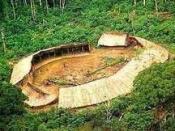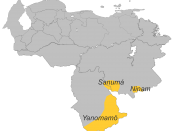Napoleon Chagnon has observed and recorded the histories of 60 Yanomami villages. The Yanomamami are Indians that live widely scattered in southern Venezuela and northern Brazil. They usually live in villages of 75 to 80 people, but there may be as few as 40 people or as many as 300 people in a single village.
The Yanomami live by a combination of horticulture and foraging. Most of what they eat has been cultivated in their gardens. Each household in the village clears their own land and tends it themselves. Chiefs, who have to produce more food to meet their obligation to provide hospitality, commonly receive help from others. A village can produce all of its needs from only three hours worth of work per person.
One characteristic of the Yanomami is that they are accustomed to violence as a result of their values and culture and because of this, the Yanomami live in a constant state of warfare.
Warfare appears as a main interest supported by a set of beliefs urging strong villages to take advantage of the weaker ones.
The Yanomami do not utilize much technology except in their weapons. The main weapon produced by the Yanomami is arrows. They make arrows that are six feet long. These arrows are very accurate. Arrows not only serve as weapons but as valuable possessions that are commonly exchanged as gifts among the Yanomami Villages that are nearby may sometimes ally so they can team up against another larger village. In order to demonstrate their friendship towards each other, the two villages trade and feast.
The men drug themselves on a daily basis with a substance called ebene, which causes an excessive production of mucous. The recipient allows for the mucous to drip freely from each nostril. It is believed among these...



Good essay
I Didnt know what you meant by yanomami but i think i ot it now.
4 out of 5 people found this comment useful.